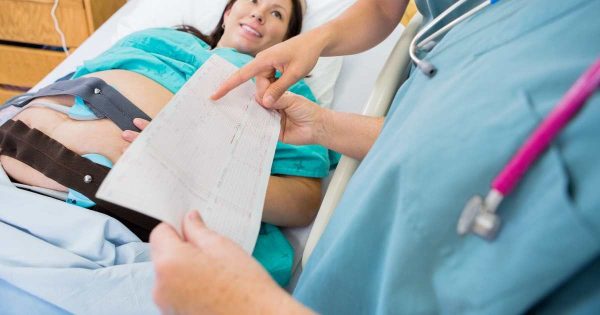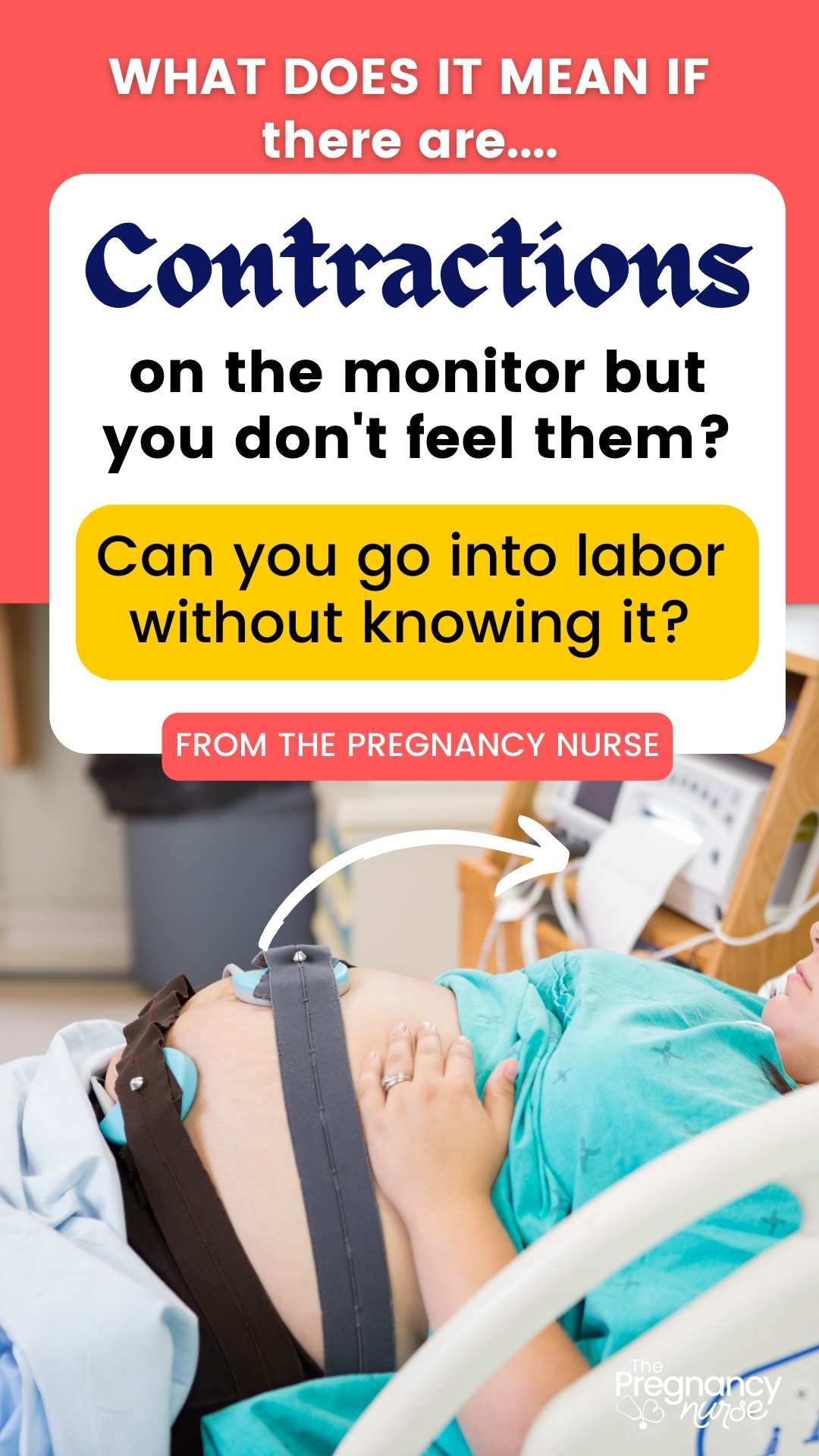When it comes to labor, there are a few different ways that contractions can be felt. For some women, they feel the same as strong menstrual cramps. Others may experience a feeling similar to gas or indigestion. And for still others, the contractions may not feel like anything at all until they are really far along in the process and baby is headed into the birth canal! What does it MEAN if you’re not feeling contractions but they’re on the monitor.

But first, how do I know so much about contractions?
Hi — I’m Hilary — The Pregnancy Nurse 👩⚕️. I have been a nurse since 1997 and I have 20 years of OB nursing experience, I am also the curly head behind Pulling Curls and The Online Prenatal Class for Couples. 🩺 I have put thousands of moms on the monitor and know how surprising it can be when you see contractions that you’re not feeling (and I have often found the cause of them). So, I’m an expert on this one.
And if you’re looking for more information about what goes on at the hospital, making it less of a mystery check out this class where we really simplify it for BOTH of you in just a few hours!
What does it mean when there are contractions on monitor but you’re not feeling them?
This isn’t unusual at all. In fact, as a nurse who did 3rd trimester testing frequently for patients I saw it a lot.
There are a few different things that could be going on if you’re not feeling contractions but they’re showing up on the monitor.
It’s possible that the contractions are very weak and not very noticeable. This can often happen in the early stages of labor. It’s also possible that the pain is being masked by other sensations, like gas, indigestion or fetal movement.
In some cases, the contractions may not be felt at all until they are stronger and you are headed into active labor.
Since, most often you’ll be on a monitor at the hospital you can easily talk to your birth team about what’s going on and what their assessment shows.
Pro Tip: These types of questions can feel really weird to ask, but don’t hesitate to ask them. We have no idea what you’re thinking, and your healthcare team is always HAPPY to answer questions. We know pregnancy is weird, and if we can make it easier, we’re here for it!
How are Contractions Monitored?
Contractions are often monitored using a device called a tocodynamometer, or contraction monitor (or toco for sure). This machine is used to accurately measure and record the strength, frequency, and duration of uterine contractions. I have a whole post on what the toco numbers mean.
And yes, we go into fetal monitoring more for you in The Online Prenatal Class for Couples, but I want to be clear that it’s not your job to READ the monitor — that’s the nurse’s job.
What Causes Contractions You Can’t Feel
Most often these tiny contractions are something we call “irritability” — which is just like it shows. Your uterus is just sort of upset. These types of contractions tend to be not as long and possibly closer together.
MOST often this happens due to dehydration. The easy fix is to drink two giant glasses of water and see if that fixes it.
This type of thing can also happen due to a bladder infection (when the uterus’s next door neighbor is upset it often gets upset as well).
Or, they might just be small contractions. These can either be early labor or possibly preterm labor if you’re before 36 weeks.
Most often large contractions are felt.
And, in general, especially if you’re past 36 weeks we don’t worry much about contractions you’re not feeling (other than making sure you don’t have a bladder infection and are hydrated). Prior to that we want to be sure that those contractions aren’t leading to preterm labor.
And we talk ALL about feeling contractions (and what to do) in here.
How Can You Tell if the Contractions are Labor?
Your provider should do a thorough assessment of both you and your uterus whenever you’re placed on the fetal monitor. They should palpate (or gentle pressing) on your abdomen to feel how hard the contractions are.
This will give them some better clues as they move forward.
Interesting note: Depending on your size and where the monitor is placed there are often contractions seen on a monitor that not even I can feel as your nurse.
If you’re before 36 weeks the hospital may do a test called Fetal Fibronectin.
In this test, they will insert a long Q-tip into your vagina and collect some of the fluids there.
That q-tip’s collected fluids will then go to the lab where they will check to see if there is a substance called Fetal Fibronectin in it.
Studies have shown that when you’re actually going into labor you will release that substance into your vagina as your cervix starts to open.
If that comes back positive for fetal fibronectin, they will likely give you medications to stop the contractions. They may also check your cervix to see how dilated it is.
Is important for the test that we NOT check your cervix prior to it, and the test also can’t be done if you’re having a lot of bleeding, or have had sex in the last 24 hours.
If the test comes back negative, they believe with some certainty that your contractions are just an irritable uterus that is not opening your cervix.
Many providers will send you home just asking you to watch for any other signs or symptoms.
If you’re past 36 weeks we will counsel you to watch for other signs of labor — and be sure you know how to contact your provider for any questions. It may be the start of labor, or it could just be irritability or small Braxton Hicks Contractions (often called “practices contractions” or “false labor”).
No matter how far along you are — come join me in my totally free pregnancy email series. I go through just what you need to know based on how far along you are — sign up right below:
Will I Go Into Labor Without Knowing It?
Many women worry that they will go into labor without knowing it when they see contractions on the monitor that they are not feeling.
They also think that labor “sure is easy” when they have these contractions.
But, I am here to tell you that both of these things aren’t very likely.
I do believe that most pregnant people have varying levels of pain with labor, and some do feel it less than other people, but everyone is VERY aware when they are in active labor without pain medications or an epidural on board.
It is EXTREMELY unlikely that you will be in labor without knowing it. Don’t worry. 😉
What Should You Do About It?
If you’re before 36 weeks you’d want to be sure to know that your cervix is not opening through the testing we talked about above.
No matter how far along you are….
You’ll also want to consider if you have a bladder infection. Do you have any symptoms like painful urination, burning when you pee or having to pee even more frequently than usual.
Beyond that you’ll just want to monitor for any other signs of labor. Ask your provider what you should be watching for.
AND drink plenty of fluids to keep your body hydrated and happy. Dehydration contractions are not the kind that will put you into labor. They just hurt and don’t open your cervix, so we don’t need any of those.
Remember that labor most often doesn’t come just on it’s own and there will likely be other parts to it that you’ll want to watch for as well.
We talk SO much about how to know if you’re in labor in The Online Prenatal Class for Couples if you are nervous about labor at all, it is a great resource (and participants feel 60% less nervous after taking it).
It’s really there to make pregnancy, and postpartum life simpler and easier to understand. In just a few hours you can feel more prepared for your birth. I hope you’ll come join me in there to answer all your questions!
Looking to get prepare for your birth? I have some easy options for you!
~~~~~~~~
– Worried you’re missing something? Grab my pregnancy planner so you don’t miss a thing!
– Thinking about an induction? Grab Inductions Made Easy to feel prepared in just 20 minutes!
– Wondering how to get that baby OUT? Grab Going Into Labor Made Easy so you know how to (and not to) do it!
– Postpartum got you anxious? Check out Postpartum Care Made Easy so you can stay SAFE even when all your attention is on that little on.
🚨 AND if ALL OF IT has got you on edge The Online Prenatal Class for Couples is perfect for you — You’ll feel so ready before you even know it!
~~~~~~~~
No matter WHERE you are at in your pregnancy journey, we have resources that can help!
And, if you’re not quite sure you’re ready for that whole thing, check out my free prenatal class. It’s your first step toward getting in the driver’s seat of your birth.







 Disneyland Pregnancy Pass: The Pregnancy Nurse shares if it’s a real thing!
Disneyland Pregnancy Pass: The Pregnancy Nurse shares if it’s a real thing!
